Why is Magento so popular?
Although it’s not the main focus on this article, we thought it would be useful to explore why the Magento platform is so popular in the world of eCommerce. The infographic below helps to explain why. It’s clear that being open source and having a global community of developers providing free/paid support, development, extensions and themes is a large reason for the popularity of Magento.
Retailers like that thy are not tied into a single provider and have the freedom to move or even support their website in-house, thus protecting their investment and helping to reduce costs.

Is Magento the best eCommerce platform? Click to view the full infographic.
Growth in mobile shopping (M-Commerce)
According to a Canadian research firm called Demac Media, mobile shopping is becoming the preferred means of buying goods online and there’s a general “mobile-first” shift among retailers.
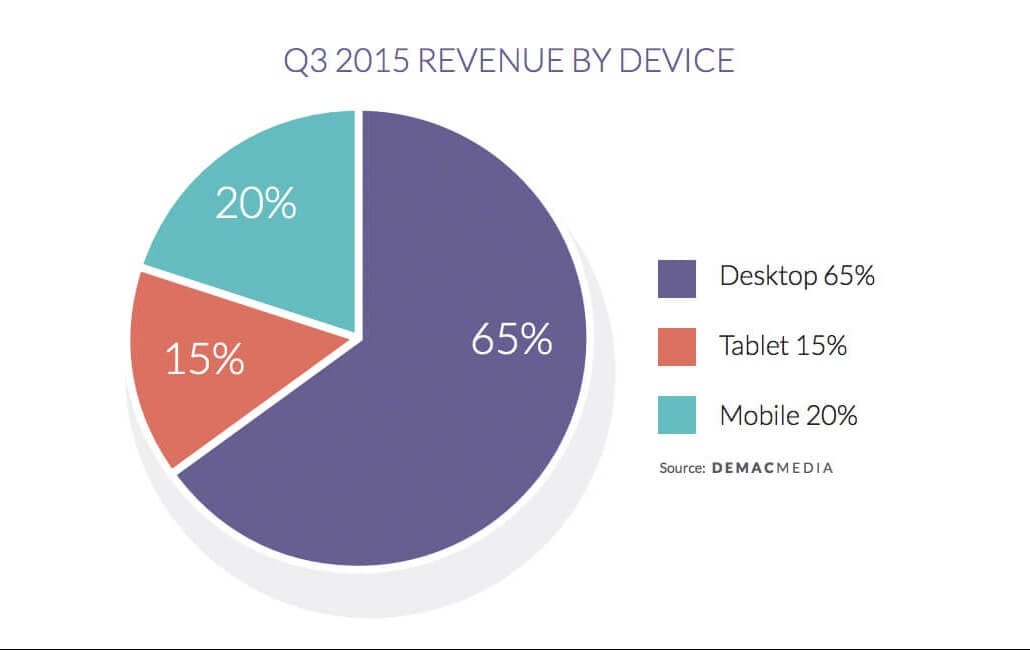
Mobile Commerce Benchmark Report from Demac Media – http://www.demacmedia.com/ecommerce/2016-year-of-mobileCommerce
The report shows that mobile devices and tables made up 35% of revenues in Q3 2015 and it’s anticipated that by 2020 mobile commerce will grow to 45% of overall eCommerce revenues, equating to $284 billion in sales.
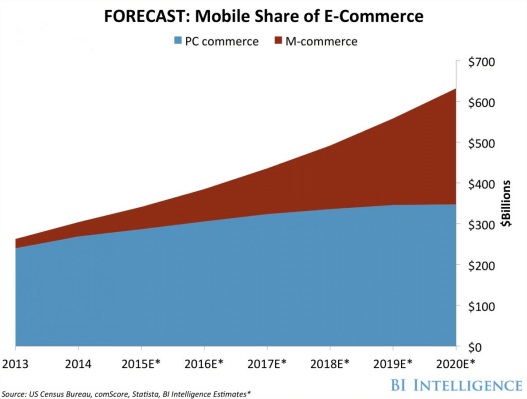
Mobile share of eCommerce from Demac Media – http://www.demacmedia.com/ecommerce/2016-year-of-mobileCommerce
A separate research report on the UK industry by CRR (Centre for Retail Research)has claimed that the UK industry is missing out on £6.6 billion due to businesses who have not yet embraced an m-commerce (mobile commerce) strategy. According to this report, 73% of UK shoppers used a mobile phone in 2015 to shop online, while 15% have already adopted their mobile phone as the primary shopping device. Yet, 40% of these customers feel that the mobile shopping experience offered by companies could be vastly improved. Looking at these figures, we can identify a trend where we know that a large number of these businesses catering to the emerging population of mobile shoppers are operating through a Magento based website.
In this article, we’ll look at the overall user experience and functionality offered by Magento for businesses who want to go mobile. But, first let’s look at Magento’s available mobile commerce offering which has been evolving over the last five years and has powered many e-businesses to go mobile.
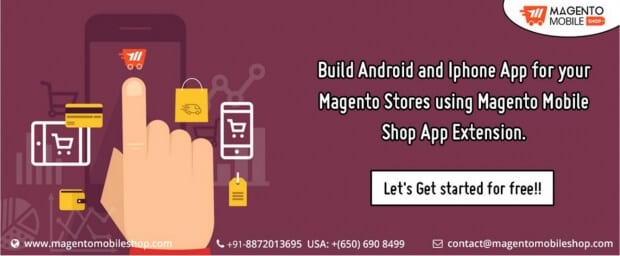
Magento mobile shop
Mobile commerce with Magento
Magento’s mobile commerce solution encourages open source development for a range of m-commerce apps with varying levels of functionality and features. The development of the m-commerce market was long predicted and Magento put a solution in place as early as 2011. The mobile apps are meant to integrate with the eCommerce platform, both Community and Enterprise editions. The apps allow businesses to take customer relationships to an entirely new and connected level and provide customers with an intuitive and easy to use, branded store front.
The Magento mobile source code allows users and customers alike to create extensions and develop mobile apps that integrate with the Magento platform to create a great user experience. Using the source code, developers can build apps and create unique features according to the requirements of the business and its customers. Mobile friendly extensions can also be created. A quick look at the Magento website reveals a number of developers who have already created some great m-commerce extensions.
Mobile-ready Magento applications (extensions)
Browsing on the Magento commerce website gives us an insight into several m-commerce ready applications that are already available to be purchased off the shelf and tweaked according to the requirements of the business. One such application is Simicart, a mobile ready app that promises to increase conversion rates, boost customer loyalty and offer a reward points and coupon program for businesses, and comes at a subscription of $499 per year. Certain applications also come for free. For example, there’s Magemob. Magemob admin is a free tool that allows online merchants to view details of the online stores on iOS. Then there’s Mobicommerce, a full-fledged m-commerce extension for your online store that even offers you a free trial. The extension promises to enhance customer experience and even sent push notifications customised to the profiles of different customers.
Seamless integration
One of the key requirements of m-commerce businesses is a high level of responsiveness, which works well for a range of different mobile devices including tablets. It’s a very futuristic and progressive field and one that allows for quick developments. In fact, handheld terminals and devices are slated for big changes in the next 5 to 10 years. Any mobile commerce platform worth its salt needs to stay ahead of these developments in the industry and Magento is definitely making serious efforts to accomplish this.
Product catalogues on eCommerce sites are expanding and needs to be integrated with the backend for quick and hassle-free order processing. In terms of user experience, product catalogues needs to be visually appealing and incorporate features like image zooming for the user to get a detailed browsing experience and understanding of the product, prior to purchase. The Magento mobile application provides this functionality and is built to integrate seamlessly with the Magento eCommerce version being run in the online store. The m-commerce version provides one admin panel for the administrators on the client sites. Again, this makes the client side experience simple and practical and training of employees easy. Magento has kept in mind the requirements of e-businesses which needs catalogues to be updated in real-time several times a week. In other big requirements of the eCommerce/M-commerce stores is a wide range of checkout capabilities, allowing shipments to different addresses, including payments through a number of methods. Magento for mobile provides these facilities.
Magento 1 or Magento 2?
In our article here (https://ecommercedesign.agency/is-now-the-right-time-to-move-to-magento-2), we explore the background behind Magento 2, the benefits and the general reactions to the new release. It’s clear that mobile commerce was a key part of the strategy for Magento 2 and with a new and improved mobile-optimised UX for the Magento Admin, retailers can manage their eCommerce stores more easily from their smart phones and tablets.
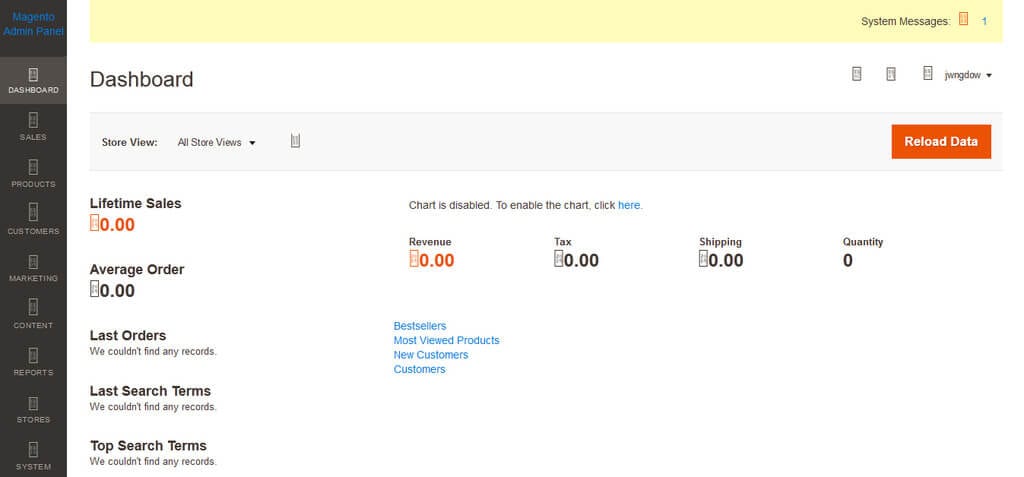
Magento 2 responsive admin screenshot
However, for the end-user, Magento 1 and Magento 2 can both provide a mobile-friendly responsive experience through responsive themes such as the popular Porto theme and mobile friendly development, so our advice is to consider the pros and cons of each version carefully before making a decision. At the current time, the “mobile factor” may not be as important as support, compatibility and cost when all things are weighted up.
Magento Enterprise for mobile
In the latest avatar of Magento, a considerable degree of mobile functionality has been reserved for the Enterprise version. Since this is the paid version, it forms part of the perks that bigger businesses would gain from by using a paid version.
Let’s take a quick look at the functionalities of Magento mobile that comes with Enterprise:
Mobile admin panel
- Real-time customisation
- Seamless integration with the store catalogue
- Updates for promotions and offers
- Option to manage several stores from a single interface
- Multiple device support integrated into one admin panel
- Efficient order and content management across all your stores
- Ability to capture CRM information
- Integration with new Magento stores and your existing ones
- Analytics and reports on application usage by customers (iPhone only)
- Support for multiple languages and currencies
Merchandising
- Option to implement themes and banners which can be changed continuously
- Effective promotion of sales and special offers
- Visually appealing display of categories and subcategories within products
- Visible reviews and ratings to enhance customer experience
- Stock availability information, which enhances customer experience
Managing the cart and checkouts
- Integration with payment applications such as PayPal Mobile and ApplePay
- Existing checkouts can also be integrated with other payment gateways such as authorize.net
Other great features
- Users enjoy consistency between the eCommerce site and the mobile application, having the same experience throughout
- Customisation and branding of the mobile store is much easier
- A high degree of control over the way content and images are presented
- New and existing user accounts are kept secure through a robust login and registration system
- Each customer as well as the admin staff get to view the order history and wish lists
- The device touchscreen works seamlessly with an intuitive user interface to deliver a high-quality shopping experience
Affordability
Going mobile is definitely not just the in thing, but a low-cost way to extend the sales platform as well as the brand. Affordability is always key for any business as lowering the cost base can provide greater advantage when it comes to comes to competitiveness. Magento preserves simplicity at its heart so that developers can create a style for clients easily. There is also a facility to preview all the features before purchasing a mobile subscription. Let’s now look at the avenues you can pursue to take your business mobile and the associated costs.
Retailers are going mobile
The IMRG Capgemini Quarterly Benchmarking 24th Feb 2016) report (uk.capgemini.com/newsuk-news/imrg-capgemini-quarterly-benchmarking-over-half-of-online-sales-now-made-through-mobile) reveals that a major digital tipping point has been reached. The percentage of UK m-commerce sales (smartphones and tablets) now exceedes 50% for the first time in Q4 2015/16, with 51% of UK online retail sales coming from smartphones.
This isn’t surprising as we seem to do everything now with the use of a smartphone. This includes controlling our household gadgets, heating equipment and kitchen appliances. Of course, shopping using a smartphone is likely to keep growing. The numbers are up from 45% recorded in Q3 and 40% from the last year. As businesses continue to jump onto this trend, in this section, we look at what it takes to take your business mobile.
What does it take to go mobile?
Process and costs for building a mobile app
You can work on getting your store front mobile ready by first purchasing a Magento application key. When you buy the application key, Magento connects you to a platform where you can start building your mobile application, which will further integrates into your eCommerce store. After that, the next step is to get onto the iOS developer program run by Apple. There is also a similar one which is the Android version. You need to then go back to Magento with the iOS username and password. Once this step is completed Magento then processes the information and this completes the submission process. The application key supports iPhone, iPad and Android devices and there is a setup fee as well as a recurring monthly or annual fee for each device class.
Of course, at this point you will probably need to hire a developer unless you are familiar with the work yourself. Your app can then be customised with your developed storefront or one of the available Magento themes. The fee covers getting the app into the app stores and all necessary maintenance. When last checked, the fee was approximately $699 per year. Most companies would try to get their mobile app ready for all device platforms and if you take maintenance into account as well, this would cost the business a little more than $2000 a year.
Bespoke app development
The next option is to create your own independent app from scratch. This would be done independent of Magento. However, as you can imagine, this could be a really expensive and time-consuming task. Large businesses that are picky about a high level of customisation would go down this route. It probably requires hiring a large team of in-house developers to work on the app, or outsourcing the job to a specialised app development company. Needless to say, after the programming of the app, developers would also need to build APIs which integrate the app to your Magento eCommerce platform. All of this could take considerable time and effort in user acceptance testing, as bugs need to be removed before the system can be fit for purpose.
The simple option – use a responsive theme/design
Lastly, in other options to take your e-business mobile is to simply use a mobile-friendly responsive Magento theme. This would present your storefront in a customised manner for different mobile devices and could be the most cost-effective version as it does not require a separate application to be built for it. However, you would require to purchase a good theme and use an independent Magento developerto customise it for your business.
A strong consideration in making this decision is that users may not specifically care about having an app installed on their phone. If the navigation is easy, the storefront looks attractive with all the features that they are normally used to, there is little evidence to prove that customers necessarily want an app. Going down this route could be well worth your while as there would be major savings in cost, part of which could be invested in a highly capable developer to customise a responsive theme to act as the storefront for your business.
The latest research from Barclays predicts that consumer spending on mobile platforms will exceed £53 billion by the year 2024. The research also claims that the impact of mobile commerce will go beyond that, and almost half of all retail sales (42%) will be impacted by a mobile device one way or another.
These statistics make interesting reading, as the report also reveals that 70% of retailers today do not currently have a mobile website or a mobile app that’s ready for customers, although, according to the research, 33% of all retail transactions and now performed by mobile. So, we can see that mobile commerce is a field with huge opportunities, not just for retailers but also for developers.
Does mobile eCommerce = Magento?
In a competitive market space, the company that controls the platform that majority of retailers build on will emerge as the market leader. This is very similar to the infamous browser wars of the mid-90s. Many of you might recall, that at the time it became apparent that the company who had market leadership in browsers installed on people’s PCs, would control Internet traffic to a degree and would also have influence on search engine results that were shown when people performed a search.
We can see that Magento has adapted itself in more ways than one in order to remain not just the platform of choice for eCommerce stores but to also be a formidable force to reckon with when it comes to m-commerce. Of course, the mobile offering has undergone many transformations in the last few years and is likely to undergo many more in the years to come. It is premature to predict which way the development of online technology will go, and so Magento has opened itself to different pathways that consumers, developers and retailers can take.
Magento used to have a free compact version for small businesses called Magento Go. However, this version was withdrawn in early 2015 to make way for increased focus on the growth and development of the Community and Enterprise versions. Needless to say, we must not forget that all the enhancements and developments that we have discussed so far are also being pursued by other competitors in the market, e.g. Shopify, Zencart, etc. So, much like the browser wars, consolidation will eventually take place in the industry and perhaps a couple of players will emerge victorious. We fervently hope that Magento or is one of them.

A selection of our older posts, written by various members of the team between 2015 to 2021.




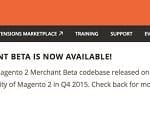



0 Comments